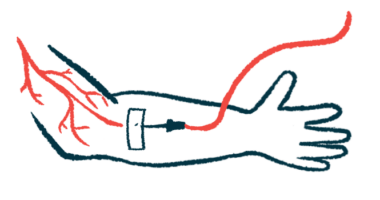Fasenra keeps EGPA in remission for up to two years: Trial data
Study’s head-to-head period showed a year on Fasenra as effective as Nucala

Up to two years of treatment with AstraZeneca’s Fasenra (benralizumab) helped adults with eosinophilic granulomatosis with polyangiitis (EGPA) that’s difficult to treat achieve and maintain disease remission, while reducing or eliminating the need for oral corticosteroids.
That’s according to combined data from the completed head-to-head portion and the ongoing open-label extension (OLE) portion of the Phase 3 MANDARA clinical trial (NCT04157348). Results from the study’s initial head-to-head period showed that a year on Fasenra was no less effective than Nucala (mepolizumab) — the only approved EGPA therapy at the time — at promoting remission of EGPA, a rare type of ANCA-associated vasculitis (AAV).
Participants completing the one-year treatment period could choose to enter MANDARA’s OLE portion, where they switched from Nucala to Fasenra or continued on Fasenra. Two-year data from both study portions showed that more than half the patients in each group remained free of relapses.
“In patients with EGPA, treatment for [two] years with [Fasenra/Nucala] was associated with durable rates of remission, discontinuation of [oral corticosteroids] and low relapse rates,” Andrew Menzies-Gow, PhD, AstraZeneca’s global medical head of respiratory biologics, said in an email to ANCA Vasculitis News.
These and other data from MANDARA’s OLE period were presented at the European Alliance of Associations for Rheumatology (EULAR) congress June 11-14 in Barcelona.
EGPA is a type of AAV where inflammation of small blood vessels is driven by eosinophil-rich granulomas — clusters of eosinophils, a type of immune cell — that can damage tissue. Eosinophilic asthma, another condition marked by high eosinophil counts, is also common with EGPA, resulting in symptoms such as shortness of breath.
“Patients suffering with EGPA have often struggled to achieve remission from existing treatments such as oral corticosteroids (OCSs) which, despite providing some relief from symptoms, can cause serious and long-term side effects,” Menzies-Gow said.
Both Fasenra and Nucala are approved for adults with EGPA. While their targets differ, both reduce inflammation by disrupting signaling from IL-5 and its receptor protein, IL-5R, which is involved in the growth, maturation, and activity of eosinophils.
Of the 140 adults with difficult-to-treat EGPA who entered MANDARA, 128 joined the open-label extension, with 66 continuing Fasenra and 62 switching from Nucala to Fasenra. A total of 119 participants (93%) completed the first year of the open-label extension portion, meaning they were treated for about two years in MANDARA.
After two years of Fasenra treatment
Data from an oral presentation, “Efficacy and Safety of Two Years of Treatment with Anti-IL-5/R Therapies for Patients with Eosinophilic Granulomatosis with Polyangiitis,” showed that, after two years, more than half the patients were in remission regardless of whether they had received Fasenra from the start or switched from Nucala (62.1% vs. 67.7%). Disease remission was defined as a Birmingham Vasculitis Activity Score (BVAS) of 0 and a low dose of oral corticosteroids.
Also, during the first year of the OLE portion, 77.3% of those always on Fasenra and 67.7% of those switching from Nucala were free of relapses.
Eosinophil counts were consistently low after one and two years of Fasenra among those always on the therapy. Such low eosinophil numbers were seen among those originally on Nucala only after about one month after switching to Fasenra.
For those on Fasenra from the start, the percentage who discontinued oral corticosteroids remained stable from the end of the yearlong, head-to-head portion to the end of the first year of the OLE (40.9% vs. 43.9%). For those who switched from Nucala, this percentage increased from 25.8% to 43.5%. The median daily corticosteroid dose was reduced by 96.7% among patients always on Fasenra and by 90.5% by those who’d switched.
Both groups also showed reductions in asthma symptoms.
“Switching from [Nucala] to [Fasenra] enhanced blood eosinophil depletion and oral corticosteroids sparing, offering significant promise in addressing this unmet need and improving outcomes for the estimated 118,000 people globally living with the disease,” Menzies-Gow said.
The most frequently reported adverse events during MANDARA were COVID-19, the common cold, and sinusitis, an inflammation of air-filled spaces in the forehead and the back of the nose, consistent with previous OLE data.
Remission rates
In a poster titled “Efficacy of Two Years of Treatment with Anti-IL-5/R Therapies According to Historic Disease Severity in Patients With Eosinophilic Granulomatosis with Polyangiitis,” the researchers showed that the benefits of both Fasenra and Nucala were consistent regardless of disease severity.
For example, remission was achieved by 74.4% of those with a history of severe EGPA and 60.2% of those without severe disease.
Data from another poster, “Efficacy of Two Years of Treatment with Anti-IL-5/R Therapy for Achieving Glucocorticoid-Free Sustained Remission in Eosinophilic Granulomatosis with Polyangiitis,” showed that 35.2% of all patients achieved remission off oral corticosteroids — defined as a BVAS of 0, no oral corticosteroids, and no relapses — by the end of the first OLE year.
Similar rates of this type of remission were found for patients always on Fasenra (34%) and those originally on Nucala (36.3%).
“These data suggest that discontinuation of OGCs while avoiding relapses is achievable with targeted anti-IL-5/R therapy and sets a new treatment goal,” the researchers wrote.







